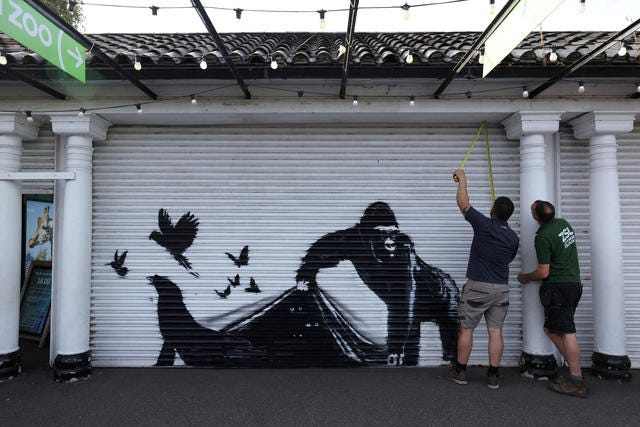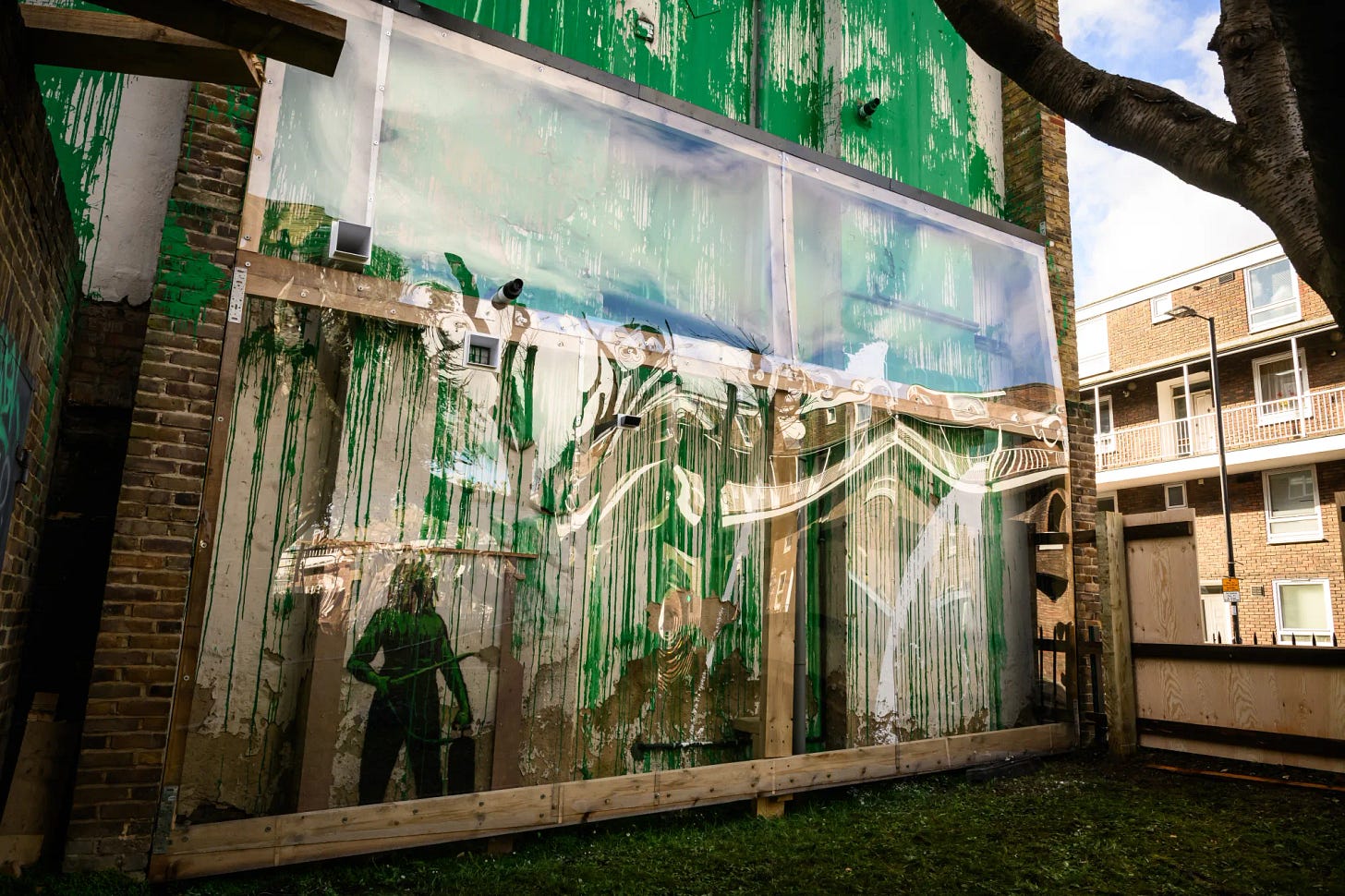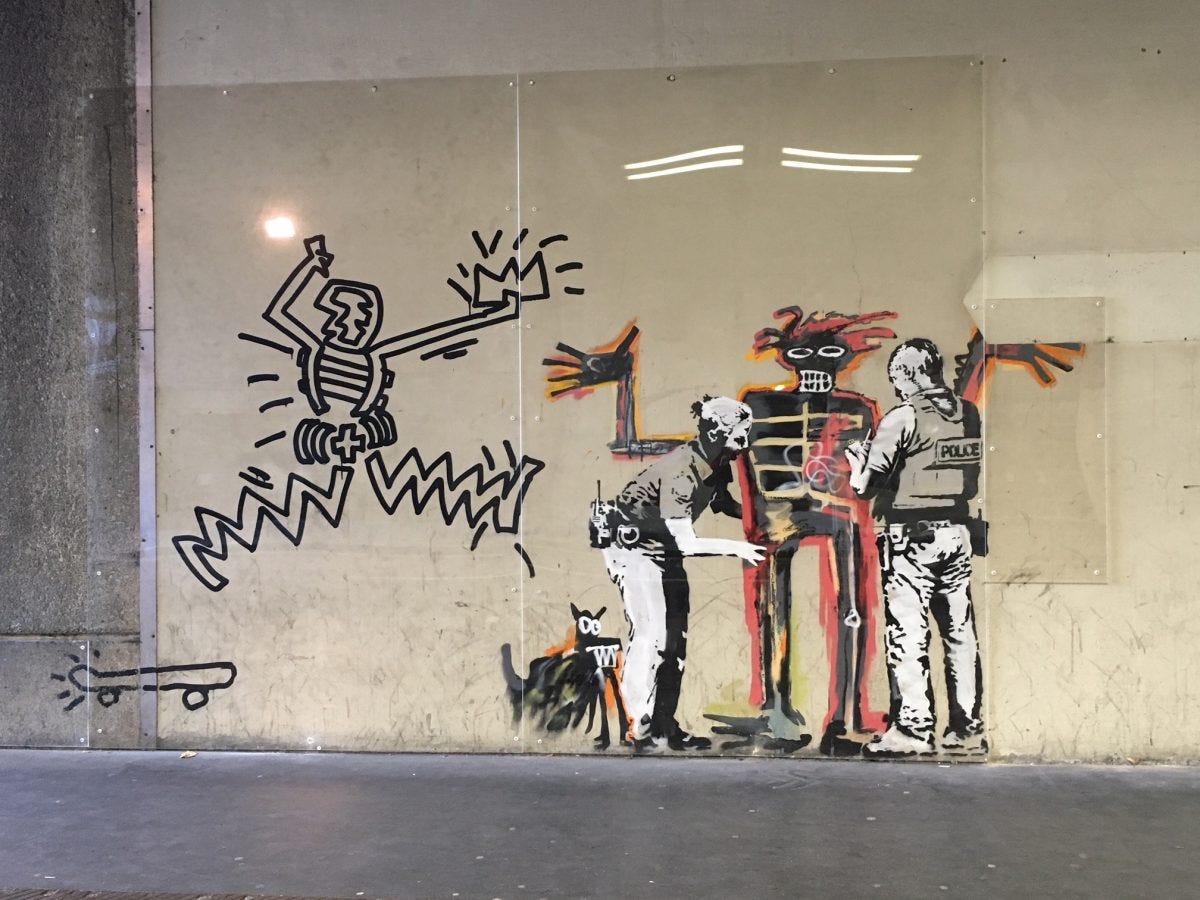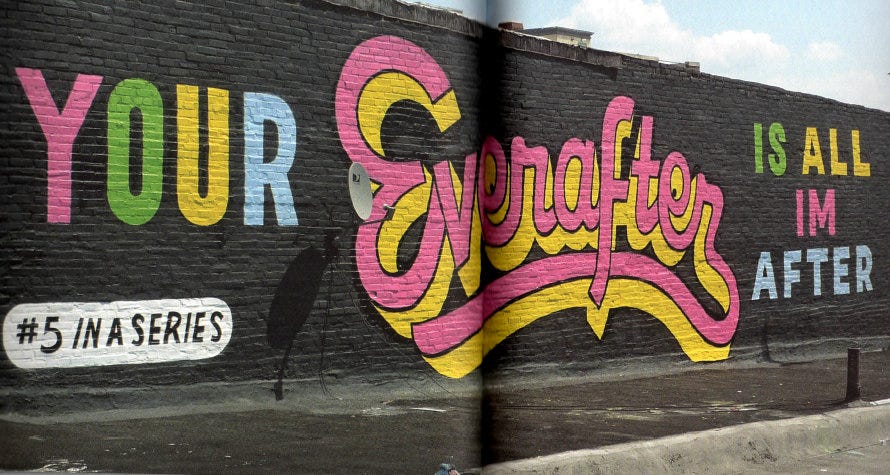Unless you’ve been living under a rock in London for last fortnight you will know that Banksy has once again graced the streets of this great city with a series of paintings. Stencils of animals, playfully positioned, appeared night after night for nine days culminating with a gorilla holding up the curtain to let them all out of the shutters at London Zoo. How wonderfully mediocre! But that’s not the point. What’s interesting is not the artwork itself but how people react to it, and how people to react to Banksy’s artwork is particularly strange.
There are basically only ever three physical responses to his work: steal it, tag it, or cover it up with plexiglass. Of those three I’m most offended by covering it with plexiglass. Before I get into the why the idea of preserving it pains me the most we need to define what it is we are actually dealing with here. Because to preserve an artwork feels like a natural step. Artworks have this inherent aura of permanence, we imagine them as being on display in spaces like museums and galleries that have stood for hundreds of years. This isn’t true of course, all artworks are slowly fading and degrading. And so are the buildings, storage facilities and centres of power that hold them safe from the vandals like erm Banksy. Permanence is only ever an illusion.
But these paintings are not in museums they are on the street, and the streets of London are always changing. Every day when I walk the same route to the studio in the morning something is different: a new billboard, sticker, tag, shopfront, scaffold or homeless person’s tent has sprung up overnight. Looking out for all of these little changes is part of why I love living in this city despite its best attempts to make me destitute. Because they’re on the street Banksy’s stencils are just another part of this continual process of change and renewal. They’re artworks if he calls them artworks, but they’re subject to the laws of the street not the gallery.
Are they then Street Art? I think its probably the least clunky way to define this series of work by Banksy. Graffiti writers hate Street Art, and galleries, and society, and women, and the police. They’re haters. And their delicate egos really hate someone being very popular. Banksy has been voted Britains most popular artist, living or dead. Which is insane. Artists are also haters, we also hate someone being very popular. I’m sure I’m not the only one who thinks Banksy’s popularity level is a little crazy. Its this hate that drives someone to go out and ruin a Banksy stencil with a smear of their own paint or quick tag with a spray can. And its a fear of this kicking over the sandcastle act that makes someone cover a stencil with plexiglass to protect it.
Often this protective intervention happens only after someone has already “vandalised” it. So what you get is a Banksy stencil half covered in a splash of magnolia paint that then gets sealed in with a sheet of plexiglass tacked to the wall with strips of wood. By anyone’s measure it looks silly. It’s then not really Street Art or Graffiti or Art art. And it’s certainly not what the artist himself intended.
Plexiglass is very ugly. Remember the pandemic? Plexiglass everywhere, hastily thrown up in a desperate attempt to contain the spread of the virus. It scratches incredibly easily, so it quickly becomes more translucent than transparent. And it reflects light in a messy warp rather than the sharp lines of actual glass. This quality pairs particularly badly with the flat matte of the masonry that the stencils are sprayed onto. Even when this has been done to a gallery standard it still looks bad. Case in point being the Bansky stencil in the Barbican tunnel in honour of the Jean Michel Basquiat. You have to wonder what Jean-Michel would have made of that aesthetic monstrosity - that extra little rectangle that covers just the arm of Basquiat-esque figure, terrible.
Why bother preserving something if the price of doing so is ruining its original reason to exist and its aesthetic execution? Money. It always comes down to money. Banksy’s work sells for shit loads. Not the Street Art, the Art art. Those same stencils rendered on canvas rather than the street sell for millions in world’s top auction houses. The art market doesn’t care that in that gallery ready form they’ve been decontextualised and neutered. All the market cares about is how much someone is willing to pay for it. And back out on the street the ones that manage to stay in place and get sealed in their plexiglass prison are a tourist trap waiting to happen. The presence of one of these stencil is enough to boost the whole area’s local economy.
The noble and correct thing to do with a freshly painted Banksy stencil would be to let it get slowly destroyed by street exposure. Let it get tagged, stickered and covered in a layer of sooty London pollution. Let it age gracefully or get it eviscerated by another spray can wielding renegade. Because 99.9% of the people who view these artworks will see the official photograph released by Banksy himself. The same photograph that will be hoovered up by legacy media institutions like the BBC or the Guardian and spat out into a series of articles that talk about Banksy as if he’s the bastard son of Santa and Batman, a masked hero dispensing gifts of delight for the people. And then follow up articles, tutting disapprovingly each time a “piece” has been tagged or removed to “jeers from onlookers”.
I don’t want to sound like too much of a Banksy hater, I’m not honestly. He’s actually a big influence on me. Dial the clock back eighteen years, he was doing his best work and I was an A-level art student. When you look in my sketchbooks from that time in amongst the cringe you’ll find stencils, inspired by Street Artists who used that medium before it became so synonymous with Banksy that anyone else who stencilled just looked like an imitator. Sign Painting is, in a literal sense, a kind of Street Art. The artist who brought me to sign painting, Steve Powers, started life as a graffiti artist during its New York hay day. Powers then switched from wild style to classic block lettering, painting what he called ‘love letters’ as murals across the East Coast. These love letters seduced me, and led me down the path of discovery to where you find me today.
I love people fucking with the aesthetics of the urban environment. There is so much concrete and brick and billboard that is crying out for a lick of paint. Just waiting for some kind of intelligent intervention that artists of all stripes could provide.
Nowadays, post Banksy, post Street Art, post Shoreditch gentrification, there are a lot more official routes for this artistic intervention to happen. Borough councils commission artists to paint murals as a cheap and shallow means of area regeneration. On their extensive application forms they ask you to extol how your design will “reflect the diverse and vibrant community, and celebrate the unique history of the area”. Boring art by committee ensues, rents rise and the local library stays closed. But hey, you’ve got a nice new “Welcome to Bruce Grove” mural with ethnically ambiguous figures dancing around it. Paint the same bit of wall unofficially and you’re risking a multi-year jail sentence, but were Banksy were to turn up and hit it with one of his stencils the council would piss themselves with delight.
Just like all the other anti-establishment movements that came out of that New York hey day Graffiti, and it’s child Street Art, have been drawn in from the margins and absorbed into the mainstream aesthetics. Neutered, just like one of Banksy’s canvases, with the offer of money and acceptance into the cultural elite. Contemporary capitalism is very good at this: dissenting voices are first ignored and then repackaged as products for people to buy as markers of their own maverick identity. In searching for images for this piece I discovered a plethora of pathetic websites already selling digitally printed images of the latest Banksy series. Seen the latest daring and radical work on Sky News? Now you too can own a piece of this renegade action for just £9.99!
There’s no way that Banksy doesn’t know that this latest work is toothless. Its nearly twenty years since he painted a series of stencils on the huge wall that Israel built along the West Bank to help cement its apartheid. A genuinely polemical work that took bravery and brought a knowledge of this illegal wall and the Israeli occupation to millions, myself included. I don’t want to begrudge an artist just having a bit of fun with their work, but this latest work is long way from that radical energy and anti-establishment attitude that helped make his name.
Now, with Israel committing a genocide before the eyes of the world, Banksy calls off the dogs and retreats into creating something for light relief. Maybe he’s like me and he finds the whole thing so overwhelmingly depressing that he’s paralysed by the horror. But really this just feels like a PR exercise, work that’s been made and released in a style designed for maximum column inches - the ideal fodder to help those legacy media institutions and their ageing audience to ignore the horror themselves. Art that functions like a sheet of plexiglass over an already sullied piece of Street Art, a transparent and cheap barrier to protect it from reality.









Ehy Archie, your post got me thinking! When Banksy kicked off his London Zoo series, I had just moved to the city and was loving the thrill of tracking down his animals all over London. But beyond the fun of the chase, what really stuck with me was how each piece had a completely different fate depending on who owned the surface it was painted on. Some vanished overnight—stolen, painted over, or removed by property owners looking to cash in. Others got “protected,” though that usually meant being boxed up behind plexiglass (which, by the way, is the worst—it doesn’t preserve anything, just traps in moisture and ruins both the artwork and the experience of it).
The whole thing made me think about the bigger picture: Who truly owns a piece of art that was never meant to be owned? The artist? The public? Or the person who just happened to have a Banksy appear on their wall one morning? This series was a perfect example of how messy street art ownership can be. Street art is made for the streets, but the second a piece became valuable, it's suddenly up for grabs. And what happens when they get taken off the wall? Does a street art piece still hold the same meaning when it’s stripped of its original context and sold at auction? I don't think so!
I try to understand these questions through writing—both on my blog and in my 12-year-old newsletter—digging into street art, gentrification, and how cities change around it. So it’s always interesting to hear a local artist’s take on it too.
The intensity of your convictions are admirable Archie. You are like a righteous freight train.